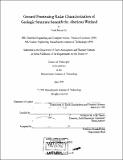| dc.contributor.advisor | M. Nafi Toksöz. | en_US |
| dc.contributor.author | Cist, David Bishop | en_US |
| dc.contributor.other | Massachusetts Institute of Technology. Dept. of Earth, Atmospheric, and Planetary Sciences. | en_US |
| dc.coverage.spatial | n-us-ma | en_US |
| dc.date.accessioned | 2010-03-25T14:52:18Z | |
| dc.date.available | 2010-03-25T14:52:18Z | |
| dc.date.copyright | 1999 | en_US |
| dc.date.issued | 1999 | en_US |
| dc.identifier.uri | http://hdl.handle.net/1721.1/53040 | |
| dc.description | Thesis (Ph.D.)--Massachusetts Institute of Technology, Dept. of Earth, Atmospheric, and Planetary Sciences, 1999. | en_US |
| dc.description | Includes bibliographical references (leaves 232-236). | en_US |
| dc.description.abstract | Ground penetrating radar (GPR) surveys are performed to determine geologic structure and to assist in the characterization and eventual modeling of ground water flow beneath the Well-H region of the Aberjona River in Woburn, Massachusetts. Even though cone penetrometer and coring studies provide point source "ground truth" data about the stratigraphy, soil chemistry, and composition of the first seven meters of peat, sand and silt they are time-consuming and labor intensive. The advantage of GPR is its ability to extend point-source ground truth information into two and three dimensions. This dissertation provides an accurate geologic model of one section of the Aberjona wetland by improving the state of three-dimensional GPR imaging. Data fusion, target implantation, and a novel 3-D migration technique are combined to render the subsurface volume accurately to resolutions of about 30 centimeters in all directions. The technique was tested using various synthetically generated models as well as carefully constructed test pits to verify its accuracy and estimate error. For our surveys in the wetland, we verify the accuracy of our method using the large database of "ground truth" information about subsurface structure and soil properties. We use this information along with data collected for this project to assemble what 3-D geological information we can. For example, direct measurements of soil bulk properties are made at various depths in several locations. Borehole conductivity surveys not only confirm core sample measurements, but also give deep conductivity information not otherwise available. Cone penetrometer surveys provide high vertical resolution to map stratigraphic variation. A 3-D resistivity survey provides general information about the conductivity of the site. In addition to ground truth measurements, several different types of radar surveys were employed to estimate soil electrical properties. A new method of Vertical Radar Profiling (VRP) was developed to provide velocity information at different locations and various depths throughout the wetland. Morphing methods were applied as an interpolation tool for surveys with broadly spaced profiles. A fast three dimensional migration algorithm was developed specifically for GPR imaging that incorporates layered velocity information and soil electrical conductivity. Ultimately, this technique is shown to offer a means of mapping larger regions of wetland stratigraphy more accurately than was currently feasible. | en_US |
| dc.description.statementofresponsibility | by David Bishop Cist. | en_US |
| dc.format.extent | 276 leaves | en_US |
| dc.language.iso | eng | en_US |
| dc.publisher | Massachusetts Institute of Technology | en_US |
| dc.rights | M.I.T. theses are protected by
copyright. They may be viewed from this source for any purpose, but
reproduction or distribution in any format is prohibited without written
permission. See provided URL for inquiries about permission. | en_US |
| dc.rights.uri | http://dspace.mit.edu/handle/1721.1/7582 | en_US |
| dc.subject | Earth, Atmospheric, and Planetary Sciences. | en_US |
| dc.title | Ground penetrating radar characterization of geologic structure beneath the Aberjona wetland | en_US |
| dc.title.alternative | GPR characterization of geologic structure beneath the Aberjona wetland | en_US |
| dc.type | Thesis | en_US |
| dc.description.degree | Ph.D. | en_US |
| dc.contributor.department | Massachusetts Institute of Technology. Department of Earth, Atmospheric, and Planetary Sciences | en_US |
| dc.identifier.oclc | 43875264 | en_US |
